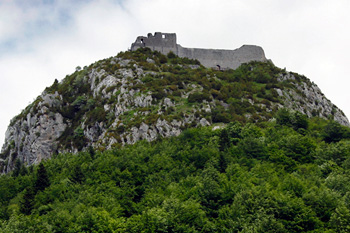
Montségur, Mirepoix and Carcassonne
by Karoline Cullen
The rocky trail angles steeply upwards and demands all my attention.
Protruding rocks and roots make for slow progress as I try not to trip. Looking at the foreboding ruin above, I find the cool, gray weather an appropriate and atmospheric match. I tackle the trail once more, clambering over obstacles to finally arrive, huffing and puffing a bit, at the entrance.
In the Languedoc region of southwestern France, I am meandering through a medieval hit list of sights. From a remote Cathar outpost to a busy market town to the stunningly restored walls of a major fortified city, these places ooze atmosphere. It is a short drive through rolling vineyards from the ruin of Montségur to the market in Mirepoix to Carcassonne, but each offers a distinct glimpse into the past.
 The ruin of Montségur perches on a hilltop in the foothills of the Pyrenees. My arduous climb to this lonely crag is rewarded with panoramic views of lush hillsides dotted with purple blooming wild sage and silent sheep. All that remains of the castle are crumbling walls and part of a keep. A sighing wind whispers over the walls.
The ruin of Montségur perches on a hilltop in the foothills of the Pyrenees. My arduous climb to this lonely crag is rewarded with panoramic views of lush hillsides dotted with purple blooming wild sage and silent sheep. All that remains of the castle are crumbling walls and part of a keep. A sighing wind whispers over the walls.
As it takes no time at all to walk around the inside, I try imagining how hundreds of people survived months of siege in such a small space during the Albigensian crusades of the 1200s. The crusades were mounted against the Cathars, whose beliefs mixed Christian and Middle Eastern philosophies. All across the Languedoc, Cathars took refuge in hilltop fortresses such as this, but to no avail. Many were martyred and the faith destroyed. I slowly circumnavigate the hilltop outside the walls. The surrounding green hills are a soothing antidote to the somber history of this windy place.
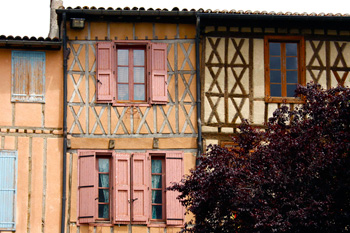 In contrast to the desolate loneliness of Montségur castle, Mirepoix is a bustling market town. Pastel coloured, half-timbered houses above wood frame arcades line the main square. Gargoyles on the church supervise the crowds around the curlicue adorned market. At the other end of the square sits the 14th century town hall. Each decorative wooden beam has a different carved head, demon, or animal.
In contrast to the desolate loneliness of Montségur castle, Mirepoix is a bustling market town. Pastel coloured, half-timbered houses above wood frame arcades line the main square. Gargoyles on the church supervise the crowds around the curlicue adorned market. At the other end of the square sits the 14th century town hall. Each decorative wooden beam has a different carved head, demon, or animal.
As in medieval times, vendors and shoppers jam the streets on market day. Mouth-watering aromas from meats cooking on rotisseries perfume the air. Sellers compete for customers with raucous cries extolling the virtues of their melons, strawberries or asparagus. A cheese maker brandishes a long saber and deftly cuts a sample of his goat cheese. I happily tell him it is marvelous and buy a piece. In a country where markets are an art form, this ranks as one of the best.
 On the opposite end of the spectrum from Montségur’s crumbling castle are the immaculately restored walls, bastions, and towers of Carcassonne’s Cité. Viewed across vineyards, the fortress stands as if from a fairy tale. Fortified since Roman times, Carcassonne was a Cathar stronghold in the Middle Ages. In the 1800s, Viollet-le-Duc imaginatively restored the double walls and the chateau they shelter. At a time when so many of France’s monuments were being neglected, he rallied for restoration. The project took fifty years and sadly, he did not live to see its glorious completion.
On the opposite end of the spectrum from Montségur’s crumbling castle are the immaculately restored walls, bastions, and towers of Carcassonne’s Cité. Viewed across vineyards, the fortress stands as if from a fairy tale. Fortified since Roman times, Carcassonne was a Cathar stronghold in the Middle Ages. In the 1800s, Viollet-le-Duc imaginatively restored the double walls and the chateau they shelter. At a time when so many of France’s monuments were being neglected, he rallied for restoration. The project took fifty years and sadly, he did not live to see its glorious completion.
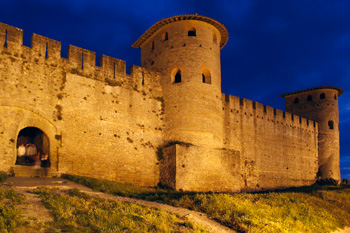 Inside the fortress, crowded narrow streets are lined with souvenir stands, restaurants, and half-timbered houses. I wander past patrons dining at tables under a leafy canopy, artists painting water colours and children in crusader outfits brandishing plastic swords. Two falconers, with their beady-eyed charges gripping their leather-gloved arms, add to the medieval atmosphere. On the grass lices between the long inner and outer sheer rock walls, I stroll in relative solitude past black slate roofed towers and square cut bastions. Carcassonne is a World Heritage Site and the fortress, while impressive by day, is stunningly lit at night. As the evening sky fades to a dusky blue and the spotlights come on, the fairy tale towers and walls glow golden. I readily imagine a centurion slowly patrolling the walls.
Inside the fortress, crowded narrow streets are lined with souvenir stands, restaurants, and half-timbered houses. I wander past patrons dining at tables under a leafy canopy, artists painting water colours and children in crusader outfits brandishing plastic swords. Two falconers, with their beady-eyed charges gripping their leather-gloved arms, add to the medieval atmosphere. On the grass lices between the long inner and outer sheer rock walls, I stroll in relative solitude past black slate roofed towers and square cut bastions. Carcassonne is a World Heritage Site and the fortress, while impressive by day, is stunningly lit at night. As the evening sky fades to a dusky blue and the spotlights come on, the fairy tale towers and walls glow golden. I readily imagine a centurion slowly patrolling the walls.
René Descartes said, “Travelling is almost like talking with men of other centuries.” In the medieval Languedoc, their stories are as varied as the places they lived.
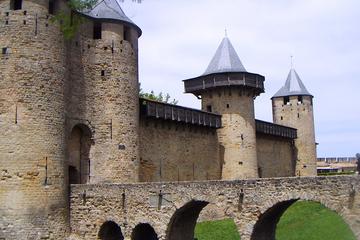
Medieval Cité of Carcassonne Guided Tour for 2 Hours
 If You Go:
If You Go:
♦ Carcasson Tourist Information
♦ Cathar & other Medieval Castles in the Languedoc-Roussillon
♦ Montségur to Mirepoix is a 40-minute drive and Mirepoix to Carcassonne is about the same distance.
About the author:
Karoline Cullen is a Photographer and Journalist
Director, British Columbia Association of Travel Writers
♦ www.bcatw.org/karoline-cullen
♦ www.cullenphotos.ca
Photos by Cullen Photos:
Montségur castle on its lonely peak
Montségur walls
Mirepoix houses
Inner and outer Carcassonne walls
Carcassonne at night
Carcassonne falcon

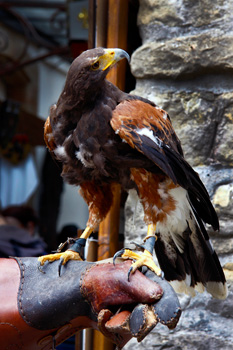 If You Go:
If You Go:

Leave a Reply
You must be logged in to post a comment.